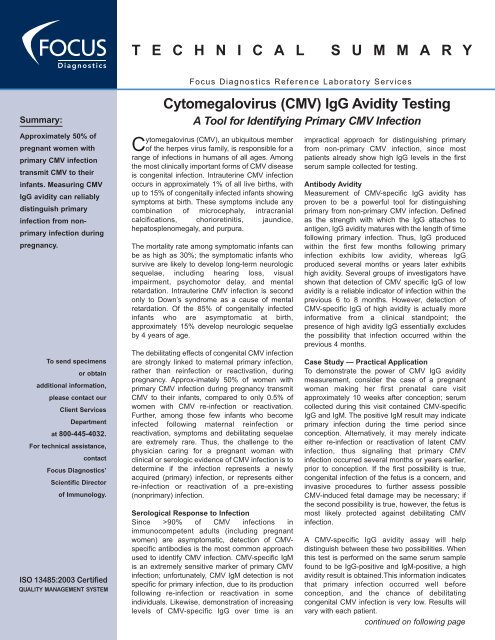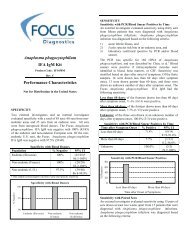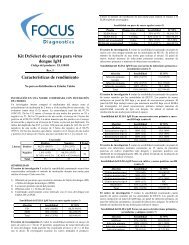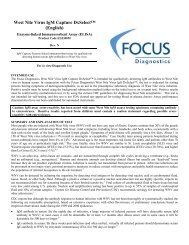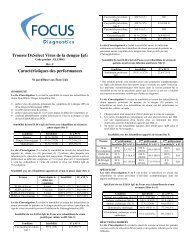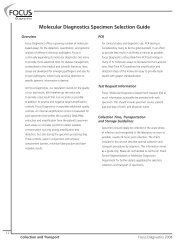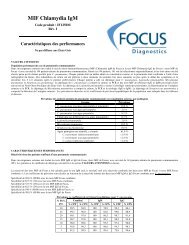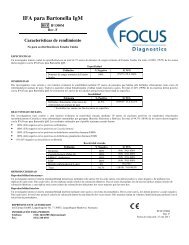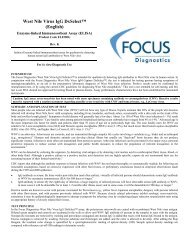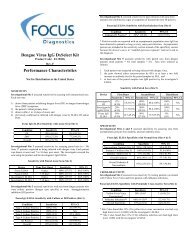Cytomegalovirus (CMV) IgG Avidity Testing ... - Focus Diagnostics
Cytomegalovirus (CMV) IgG Avidity Testing ... - Focus Diagnostics
Cytomegalovirus (CMV) IgG Avidity Testing ... - Focus Diagnostics
You also want an ePaper? Increase the reach of your titles
YUMPU automatically turns print PDFs into web optimized ePapers that Google loves.
T E C H N I C A L S U M M A R Y<strong>Focus</strong> <strong>Diagnostics</strong> Reference Laboratory ServicesSummary:Approximately 50% ofpregnant women withprimary <strong>CMV</strong> infectiontransmit <strong>CMV</strong> to theirinfants. Measuring <strong>CMV</strong><strong>IgG</strong> avidity can reliablydistinguish primaryinfection from nonprimaryinfection duringpregnancy.To send specimensor obtainadditional information,please contact ourClient ServicesDepartmentat 800-445-4032.For technical assistance,contact<strong>Focus</strong> <strong>Diagnostics</strong>’Scientific Directorof Immunology.ISO 13485:2003 CertifiedQUALITY MANAGEMENT SYSTEM<strong>Cytomegalovirus</strong> (<strong>CMV</strong>) <strong>IgG</strong> <strong>Avidity</strong> <strong>Testing</strong>A Tool for Identifying Primary <strong>CMV</strong> Infection<strong>Cytomegalovirus</strong> (<strong>CMV</strong>), an ubiquitous memberof the herpes virus family, is responsible for arange of infections in humans of all ages. Amongthe most clinically important forms of <strong>CMV</strong> diseaseis congenital infection. Intrauterine <strong>CMV</strong> infectionoccurs in approximately 1% of all live births, withup to 15% of congenitally infected infants showingsymptoms at birth. These symptoms include anycombination of microcephaly, intracranialcalcifications, chorioretinitis, jaundice,hepatosplenomegaly, and purpura.The mortality rate among symptomatic infants canbe as high as 30%; the symptomatic infants whosurvive are likely to develop long-term neurologicsequelae, including hearing loss, visualimpairment, psychomotor delay, and mentalretardation. Intrauterine <strong>CMV</strong> infection is secondonly to Down’s syndrome as a cause of mentalretardation. Of the 85% of congenitally infectedinfants who are asymptomatic at birth,approximately 15% develop neurologic sequelaeby 4 years of age.The debilitating effects of congenital <strong>CMV</strong> infectionare strongly linked to maternal primary infection,rather than reinfection or reactivation, duringpregnancy. Approx-imately 50% of women withprimary <strong>CMV</strong> infection during pregnancy transmit<strong>CMV</strong> to their infants, compared to only 0.5% ofwomen with <strong>CMV</strong> re-infection or reactivation.Further, among those few infants who becomeinfected following maternal reinfection orreactivation, symptoms and debilitating sequelaeare extremely rare. Thus, the challenge to thephysician caring for a pregnant woman withclinical or serologic evidence of <strong>CMV</strong> infection is todetermine if the infection represents a newlyacquired (primary) infection, or represents eitherre-infection or reactivation of a pre-existing(nonprimary) infection.Serological Response to InfectionSince >90% of <strong>CMV</strong> infections inimmunocompetent adults (including pregnantwomen) are asymptomatic, detection of <strong>CMV</strong>specificantibodies is the most common approachused to identify <strong>CMV</strong> infection. <strong>CMV</strong>-specific IgMis an extremely sensitive marker of primary <strong>CMV</strong>infection; unfortunately, <strong>CMV</strong> IgM detection is notspecific for primary infection, due to its productionfollowing re-infection or reactivation in someindividuals. Likewise, demonstration of increasinglevels of <strong>CMV</strong>-specific <strong>IgG</strong> over time is animpractical approach for distinguishing primaryfrom non-primary <strong>CMV</strong> infection, since mostpatients already show high <strong>IgG</strong> levels in the firstserum sample collected for testing.Antibody <strong>Avidity</strong>Measurement of <strong>CMV</strong>-specific <strong>IgG</strong> avidity hasproven to be a powerful tool for distinguishingprimary from non-primary <strong>CMV</strong> infection. Definedas the strength with which the <strong>IgG</strong> attaches toantigen, <strong>IgG</strong> avidity matures with the length of timefollowing primary infection. Thus, <strong>IgG</strong> producedwithin the first few months following primaryinfection exhibits low avidity, whereas <strong>IgG</strong>produced several months or years later exhibitshigh avidity. Several groups of investigators haveshown that detection of <strong>CMV</strong> specific <strong>IgG</strong> of lowavidity is a reliable indicator of infection within theprevious 6 to 8 months. However, detection of<strong>CMV</strong>-specific <strong>IgG</strong> of high avidity is actually moreinformative from a clinical standpoint; thepresence of high avidity <strong>IgG</strong> essentially excludesthe possibility that infection occurred within theprevious 4 months.Case Study — Practical ApplicationTo demonstrate the power of <strong>CMV</strong> <strong>IgG</strong> aviditymeasurement, consider the case of a pregnantwoman making her first prenatal care visitapproximately 10 weeks after conception; serumcollected during this visit contained <strong>CMV</strong>-specific<strong>IgG</strong> and IgM. The positive IgM result may indicateprimary infection during the time period sinceconception. Alternatively, it may merely indicateeither re-infection or reactivation of latent <strong>CMV</strong>infection, thus signaling that primary <strong>CMV</strong>infection occurred several months or years earlier,prior to conception. If the first possibility is true,congenital infection of the fetus is a concern, andinvasive procedures to further assess possible<strong>CMV</strong>-induced fetal damage may be necessary; ifthe second possibility is true, however, the fetus ismost likely protected against debilitating <strong>CMV</strong>infection.A <strong>CMV</strong>-specific <strong>IgG</strong> avidity assay will helpdistinguish between these two possibilities. Whenthis test is performed on the same serum samplefound to be <strong>IgG</strong>-positive and IgM-positive, a highavidity result is obtained.This information indicatesthat primary infection occurred well beforeconception, and the chance of debilitatingcongenital <strong>CMV</strong> infection is very low. Results willvary with each patient.continued on following page
<strong>Cytomegalovirus</strong> (<strong>CMV</strong>) <strong>IgG</strong> <strong>Avidity</strong> <strong>Testing</strong>Description of Method<strong>Focus</strong> <strong>Diagnostics</strong>’ <strong>CMV</strong> <strong>IgG</strong> avidity ELISA utilizes urea, an agentthat disrupts hydrogen bonds, to differentiate low avidity from highavidity antibodies. Following attachment to immobilized antigen,low avidity <strong>IgG</strong> readily dissociates from the antigen in the presenceof urea, whereas high avidity <strong>IgG</strong> does not. Thus, avidity isassessed by performing duplicate sets of the routine enzymelinkedimmunosorbent assay (ELISA) for <strong>CMV</strong>-specific <strong>IgG</strong>; theonly difference is that, after the initial incubation, one set is washedwith buffer containing urea, and the other set is washed with bufferlacking urea.The <strong>CMV</strong>-specific <strong>IgG</strong> signal (optical density) of the set washedwith urea buffer is then divided by the <strong>CMV</strong>-specific <strong>IgG</strong> signal ofthe set washed with non-urea buffer, thus providing the avidityindex (AI). AI values ≤ 0.50 indicate low avidity, values of 0.51-0.59indicate intermediate avidity, and values ≥ 0.60 indicate highavidity.<strong>Focus</strong> <strong>Diagnostics</strong> evaluated their <strong>CMV</strong> <strong>IgG</strong> avidity ELISA usingtwo panels of well characterized sera. The first panel included <strong>CMV</strong><strong>IgG</strong> positive sera from pregnant women who had recentlyseroconverted following primary <strong>CMV</strong> infectionThe first panel included <strong>CMV</strong> <strong>IgG</strong> positive sera from pregnantwomen who had recently seroconverted following primary<strong>CMV</strong> infection. All sera were collected in the 4-month periodfollowing the last <strong>IgG</strong> negative sample. The second panelincluded sera from patients with past <strong>CMV</strong> infection, as shownby a <strong>CMV</strong> <strong>IgG</strong> positive/ IgM negative profile.The resultsshowed that 99% of sera from patients with primary <strong>CMV</strong>infection exhibited low avidity, whereas 98% of sera frompatients with past <strong>CMV</strong> infection exhibited high avidity.SummaryIn summary, assessment of <strong>CMV</strong>-specific <strong>IgG</strong> avidity is apowerful tool for estimating the time of <strong>CMV</strong> infection. Suchinformation is particularly important in the clinical managementof pregnant women found to be positive for <strong>CMV</strong> antibodies attheir first prenatal visit. Determining the time of primaryinfection can help guide decisions regarding antiviral therapyby identifying those women who should or should not betreated during pregnancy. <strong>CMV</strong> <strong>IgG</strong> avidity measurement alsohas broad applicability to the management of other patientgroups with an increased risk of debilitating <strong>CMV</strong> disease,such as solid organ transplant recipients.For complete specimen information and CPT codes view ourReference Laboratory test listing on our Web site at www.focusdx.comCode #Test Description42600 <strong>Cytomegalovirus</strong> (<strong>CMV</strong>) <strong>IgG</strong> <strong>Avidity</strong> ELISA2426 <strong>Cytomegalovirus</strong> (<strong>CMV</strong>) Recent Infection Antibody PanelPanel includes:<strong>Cytomegalovirus</strong> (<strong>CMV</strong>) <strong>IgG</strong> Antibody, ELISA<strong>Cytomegalovirus</strong> (<strong>CMV</strong>) IgM Antibody, ELISA<strong>Cytomegalovirus</strong> (<strong>CMV</strong>) <strong>IgG</strong> <strong>Avidity</strong> ELISAREFERENCES:• Baccard-Longere M et al. Multicenter evaluation of a rapid and convenient method for determination of cytomegalovirus immunoglobulin G avidity. Clin Diagn LabImmunol 8:429-431,2001• Bodeus M et al. <strong>Avidity</strong> of <strong>IgG</strong> antibodies distinguishes primary from non-primary cytomegalovirus infection in pregnant women. Clin Diagn Virol 9:9-16,1998• Bodeus M, Goubau P. Predictive value of maternal-<strong>IgG</strong> avidity for congenital human cytomegalovirus infection. J Clin Virol 12:3-8,1999• Bodeus M et al. Ability of three <strong>IgG</strong>-avidity assays to exclude recent cytomegalovirus infection. Eur J Clin Microbiol Infect Dis 20:248-252,2001• Eggers M et al. Combination of microneutralization and avidity assays: improved diagnosis of recent primary human cytomegalovirus infection in single serum sampleof second trimester pregnancy. J Med Virol 60:324-330,2000• Fowler SL. A light in the darkness: predicting outcomes for congenital cytomegalovirus infections. J Pediatr 137:4-6,2000• Gangeot-Keros L et al. Value of cytomegalovirus (<strong>CMV</strong>) <strong>IgG</strong> avidity index for the diagnosis of primary <strong>CMV</strong> infection in pregnant women. J Infect Dis 175:944-946,1997• Lazzarotto T et al. <strong>Avidity</strong> of immunoglobulin G directed against human cytomegalovirus during primary and secondary infections in immunocompetent andimmunocompromised subjects. Clin Diagn Lab Immunol 4:469-473,1997• Lazzarotto T et al. Anticytomegalovirus (anti-<strong>CMV</strong>) immunoglobulin G avidity in identification of pregnant women at risk of transmitting congenital <strong>CMV</strong> infection. ClinDiagn Lab Immunol 6:127-129,1999• Lazzarotto T et al. Maternal <strong>IgG</strong> avidity and IgM detected by blot as diagnostic tools to identify pregnant women at risk of transmitting cytomegalovirus. Viral Immunol13:137-141,2000• Lazzarotto T et al. Prenatal indicators of congenital cytomegalovirus infection. J Pediatr 137:90-95,2000• Lazzarotto T et al. New advances in the diagnosis of congenital cytomegalovirus infection. J Clin Virol 41: 192-197, 2008.To send specimens or obtain additional information, please contact our Client Services Department at 800 445 4032.For technical assistance, contact <strong>Focus</strong> <strong>Diagnostics</strong>’ Scientific Director of Immunology.800-445-0185 • 714-220-1900 • Fax: 714-220-9213Cypress, California 90630 USAwww.focusdx.comRL<strong>CMV</strong>0509


